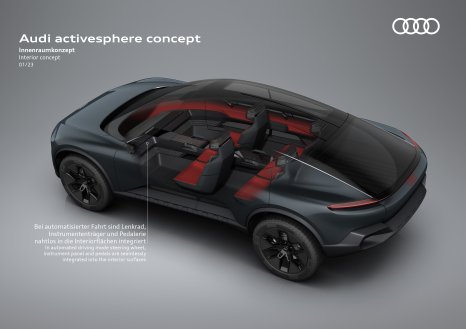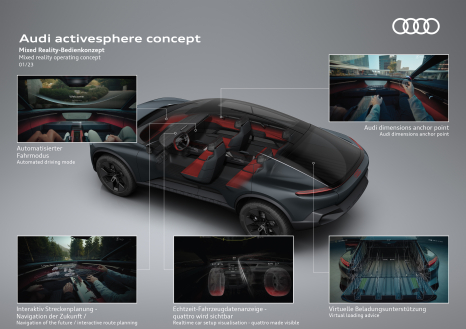Audi activesphere concept - Mixed reality operating concept
Prioritized interior – people-focused
“Sphere” sets the tone: the common name component of the Audi skysphere, grandsphere, urbansphere, and now also the activesphere, alludes to the interior. Kilowatts and km/h or lateral acceleration are no longer at the top of the design specifications for this new generation of cars. Instead, the starting point is the interior, the occupants’ living and experience sphere whilst traveling. Their needs and desires shape the space, the architecture, and the functions.
With that reassessment, the design process itself changes. At the beginning of all discussions, the focus is directed toward the interior and its design. Only then are the package, proportions, and lines of the exterior designed.
Functional and minimalist – the interior
The epitome of clarity and tidiness – this is the first impression for passengers as they climb into the interior of the Audi activesphere through the wide-open doors.
Vertical and horizontal surfaces, along with right angles dominate the architecture of the space. The interior zones feature horizontal contrasting coloring and the reigning centerpiece is the seating surfaces and door and front paneling in warm lava red, which contrast with the dark exterior even when looking through the side windows. Above and below this central zone, dark colors (black, anthracite, and dark gray) also dominate.
The four individual seats are suspended like extensions of the high, full-length center console. Resting on the center console, the upper end of the seat shell’s inner side is shaped horizontally as an armrest. The designers imagined the seat, back, and shoulder surfaces as three separate, circumferential shells; the visual appearance alone already promises good lateral support. They also appear so light as to float and thus maintain the balance between automotive function and the elegance of a lounge chair.
When the Audi activesphere concept is driving in autonomous mode, the dashboard, steering wheel, and pedals disappear into an invisible position. Especially in the first row of seats, a wide space opens in front of the driver, which extends to the front end of the activesphere – and beyond. For a clear field of vision, the fully glazed Singleframe gives passengers an unobstructed view of the road in front.
The dashboard itself works like a xlarge soundbar (through the wood lammels) as well as a smart, full width airvent in both the deployed and stowed position.
If the driver wants to take over the wheel, the dashboard, along with the steering wheel, swivels out from its flush position below the windshield – each driver can adjust the ideal ergonomic position individually. The MMI touchless controls in the doors are always accessible to the eye and the hand,for example to control windows and seat adjustments.
The architecture and sense of space in the Audi activesphere are largely determined by the high, full-length center console. Of course, in electric cars the console is no longer needed to hold a cardan shaft, but instead offers space for storage and an on-board bar - either cooled or heated. The top cover is transparent, which provides a view of the bottle and glasses, but also visually integrates the voluminous console in the interior. Additionally, there is a console in the roof, directly above the center console and reflecting its dimensions, where the four AR headsets for the mixed reality system are kept within easy reach for all passengers.
Audi dimensions – traversing worlds
Crossing boundaries is the strength of the Audi activesphere concept – and this also applies to the interface between the car, the user, and the environment. For the first time, the new system combines physical reality and the digital sphere to create a new world: the Audi dimensions.
The centerpiece of the new system is innovative mixed reality headsets – available individually for each driver and passenger. Users also have access to a comprehensive digital ecosystem while they’re in the Audi activesphere.
In the early days, VR goggles were limited to depicting a virtual reality without any real-world elements. However, technology evolved into augmented reality, whereby the real world is superimposed with virtual content. Mixed reality is now able to depict virtual content with spatial reference to the real world in three dimensions. There’s no doubt about it: in the future, mixed reality will take the possibilities of AR head-up displays to a whole new level in terms of flexibility, precision, and displayable content.
The Audi activesphere concept is the first to use a pioneering generation of this technology, which in turn adds the dimension of interaction to the dimension of superimposed real and digital worlds. With unprecedented optical precision, highest resolution, and excellent contrast, the system brings control surfaces and displays, invisible to the unaided eye, into the user’s field of vision while behind the steering wheel.
In other words, the user can view virtual content, which is initially for information only. If the user focuses with his or her eyes on the information, thus signaling interest, the system displays more detailed information. Content becomes an active and interactive element as soon as the user is focused and engages, i.e., with gestures.
The hand can then intuitively follow the user’s gaze to control car functions, while the user interface (the virtual display in the headset) reacts to changes in real time like a conventional instrument. A particularly user-friendly feature, the virtual control moves towards the user so that he or she can interact comfortably with the user interface, regardless of sitting position.
The tidy, spacious interior of the Audi activesphere no longer has to take a back seat to the function of keyboards and scale batteries, as was always the case in classic car cockpits. Only when users need an element does it appear, and it can be operated just as intuitively as it would in the real world. Important: The diverse functions of the car are now not organized in the typical way they are today in a car with screens and physical function. But they are instead located logically directly in front of the elements they are related to. Just two examples: the AC control hoovers in front of the airvent, the entertainment and sound interactive panel hoovers over the speaker.
However, the possibilities of this technology are by no means exhausted. In off-road mode, for example, high-resolution 3D topography graphics can be projected onto the real landscape and information on navigation and the destination can be displayed. Traffic safety information, i.e., alerts for traffic jams or slippery roads, can also be used here.
Depending on their needs and tasks, passengers and drivers are provided with very individual content in their respective mixed reality headset. With the driver concentrating on steering while active behind the wheel, passengers can begin looking into and even preparing activities at the destination.
Yet, at the same time they can also control the temperature and air supply for their seating area with the air conditioning, as well as browse the music selection of the sound system, which each occupant can use individually. Because the headsets are precisely designed to match the geometry of the activesphere interior, they can even project virtual index cards onto the center console to visualize access to web content. Since the sensors of the mixed reality headsets measure the interior with millimeter precision, virtual content can be superimposed according to personal requirements and even used for individual interaction.
The connection between the headset users and the car, along with its ecosystem, offers countless possibilities, even when outside the car. For example, while navigation routes or vehicle maintenance can be prepared today from your living room on a laptop or tablet, in the future mixed reality technology and the headset will be the only hardware required.
Conversely, the activesphere passenger can take his or her headset out of the car and onto the ski slope to help navigate the bike trail or to find the ideal descent when skiing downhill.
Information about the car itself, the battery range, and the nearest charging stations can also be accessed inside and outside the vehicle. And when needed, there are also advance warnings such as of low tire pressure as well as a weather forecast function as a criterion for selecting a route.
Status 1/2023

